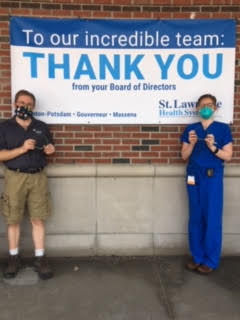Potsdam, NY – As our global world faces critical challenges to human health, now and into the future, faculty and staff at Clarkson University are applying their vast expertise in areas like airborne particle properties, sustainable battery life, mechanical and electrical engineering in, HVAC systems, and engineering design to collaborate on several projects to help St. Lawrence Health System’s medical team provide enhanced, safe, COVID-19 critical care.
“We have a long and rich history with Canton-Potsdam Hospital (CPH) and St. Lawrence Health System (SLHS) and it continues to develop exponentially,” said Clarkson President Tony Collins. “When David Acker requested technical expertise, our schools across the University were prepared with a plan and a formal Memorandum of Understanding within 72 hours; underscoring the deep partnership our organizations have with one another. Professors, students, providers, and patients all, undoubtedly, benefit from our collaborative efforts.”

“Our organization’s fundamental sustainability is integrally intertwined with Clarkson and the other universities within St. Lawrence County. The high quality of healthcare provided to our community directly correlates with the continued vibrancy of the universities. We must, more than ever, remain vigilant in supporting these essential collaborations. There can be no guarantee of safety or security from the COVID virus in any community until the vaccine arrives; however, we have demonstrated on a relative scale, that through the partnership between Clarkson’s specialists and our own, we are a very safe environment in which care can be provided and received,” said David B. Acker, FACHE, SLHS President and CEO.
PAPR Battery Modifications
A top priority project was to enhance upon the existing battery life of the System’s Positive Air Pressure Respirators (PAPRs). These critical personal protective equipment (PPE) devices help protect healthcare providers from COVID-19 in specific cases where risk of exposure is high.
Bill Jemison, Dean of the Coulter School of Engineering, and Tony Collins, Professor of Innovative Engineering Culture and an electrical engineer, suggested modifying the PAPRs to operate from longer-life batteries. Within two days, Jemison had a working prototype of the modified PAPR unit in his basement. After a total of 29 different modifications, the batteries were maintaining a continuous and consistent air flow rate for an entire clinical 12-hour shift; allowing those donning the equipment to complete a full shift without an interruption in patient care to replace the battery.
Emergency Department Respiratory Unit Design
Before the Pandemic surfaced in the North Country, CPH’s infection prevention team identified a need for a first-stop ED COVID Triage area for patients showing COVID symptoms and/or have identified potential exposure. The System’s facilities and construction teams immediately went to work designing and building a new Emergency Department Respiratory Unit (EDRU) just inside the main entrance of the Hospital.
“Separating potential COVID patients from other patients within the ED was one critical step in preventing the transmission of the virus within our facility. If a patient requires hospitalization for COVID symptoms, they are tested and transported directly to our designated Airborne Precaution Unit. If the patient does not require hospitalization, they are tested and asked to self-isolate at home until the test results come back,” said CPH ED Chair Julie Vieth, MBChB, FAAEM, FACEP.
Simultaneously, CPH was renovating two floors to be equipped as Airborne Precaution Units (APU), in the event there was a surge in COVID patients. Renovations included the installation of a 25 ton portable air supply unit that brings filtered and conditioned fresh air into the Hospital and ensures individual negative air units in each room work properly. Once installed, Clarkson’s team of specialists were invited to review the current equipment and provide ideas for enhancing air flow efficiencies. After a few modifications, all APU patient areas were fully equipped to provide safe air flow.
“HVAC Specialist Jim Eames and I spoke with SLHS HVAC staff. Through our discussions, we helped confirm that planned initiatives by SLHS personnel would be effective in producing proper air flow in containment areas. Additionally, we were able to review the Hospital infrastructure to help uncover other possible opportunities for additional HVAC performance,” said University Engineer Mike Tremper.
Clear Intubation Safety Box
Each time a patient is intubated, there is a high-risk moment of staff exposure to airborne droplets; especially around the mouth, nose, and eyes. To help minimize the risk to staff, Clarkson Coulter School of Engineering Machine Shop built clear intubation and transport covers specific for SLHS’s clinical team. Built by Machine Shop Supervisor Jacob Weller and Machinist Mark Hebel, the holes and see-through design allow staff to safely conduct the intubation procedure in a contained, lower-risk environment.
Similarly, a second cover was designed for transporting patients to the Airborne Precaution Unit.
“This cover was designed to help reduce exposure to the air-born virus to general hospital staff and other patients. Because of its larger size, Hospital officials requested it be foldable for storage purposes. We designed a system utilizing interlocking slots and tabs to allow it to easily be disassembled,” Weller said.
N95 Mask Sterilization Process

Although facilities across the System were never without PPE, the infectious disease and infection prevention teams began investigating ways to sanitize and reuse select PPE, in the event a shortage occurred. Inspired by a sanitization method used in Nebraska and upon the recommendation of Clarkson’s engineering team, SLHS implemented a UV cleaning method using their Surfacide ultraviolet sterilization technology.
“When this pandemic started, it was clear that personal protective equipment (PPE) was going to become a problem,” said Doug Bohl, Clarkson Associate Professor of Mechanical and Aeronautical Engineering. “We saw that we could rapidly deplete all of our PPE, particularly N95 respirators, so we began looking at ways to safely reuse them. We knew from published research that UV light would disinfect N95 masks effectively. But we also knew that both extended use and the UV light sterilization would cause the elastic straps on the masks to degrade and lose their elasticity, and that then the respirator would no longer be protective.”
Bohl designed a new strapping system for the masks where the mask sits inside a cage with longer lasting straps to provide a more reliable seal with extended use or reuse after UV disinfection. With this cage, the straps that come with the mask are only needed for positioning on the face and are no longer the only way the respirator is sealed to the face. He 3-D printed a prototype, refined the shape of the cages and produced them through Clarkson’s Shipley Center and one of its Incubator tenants, Evolution Prototypes.
As the North Country reopens activities under the new ‘normal’, Clarkson University and St. Lawrence Health System are already implementing the next phase of enhanced safety measures, including acquiring point of care testing. Point of care testing will prove a vital resource as students return to the North Country in the fall, and will afford Clarkson’s Physician Assistant students with invaluable hands-on experience through their clinical rotations.
Click here for a shareable link: https://www.clarkson.edu/news/clarkson-university-partners-st-lawrence-health-system-covid-19-related-initiatives


